Recent Bought with Comment Spam
Having recently re-designed this blog and converted it to WordPress, I knew it was only a matter of time before I would be bombarded with comment spam. The good news is that it’s a predictable problem and there are solutions out there to help deal with this.
Without going into details, and thereby not giving the comment spammers any hints on how I’m blocking them, I’ve made some backend modifications to handle this issue. I believe that all the comment spam you might have recently seen has been removed. And as far as I can tell from monitoring the changes over the last few days, you shouldn’t see any more comment spam here again.
Permalink to this article Discussions (2)
An Ounce of Prevention Really is Worth a Pound of Cure
I again re-learned from first-hand experience that an ounce of prevention really is worth a pound of cure. How? Two of the windows to my own house leaked because the caulking had gotten old and cracked which caused water to leak in. The water saturated some of the framing wood, caused a lot of mold (in no time at all might I add), and basically ended up with two half walls being replaced to get at the problem. A very expensive lesson to learn again.
For those of you who read this blog regularly, you know that I’ll look at the numbers to really see if the cost of the prevention really outweighed the cost of the repairs. So let’s not waste anymore time and look at them right away.
Since the costs for the repairs can fluctuate quite a bit, I’ll make a worse and best case scenario. In the best case scenario, which luckily pretty much happened for me, you won’t need to replace the actual windows (especially if they’re higher-end windows), much of the framing, any of the flooring, etc. The worse case is that everything is completely water saturated and full of mold. In my particular case, in both rooms only the framing below the windows was saturated with water and mold. The rest of the framing, the flooring, and the windows were all ok. So what’s the total cost? Seeing as I had to rip open two walls, replace some framing, etc., a round number of $1000 for labour and materials is easy to achieve. This could however easily climb to $5,000 – $10,000 if new windows need replacing, if the floor is finished, if the water damage spread to the floor below, etc. So let’s assume a small round number of $2,500. Is the prevention worth $2,500?
I quickly went to Amazon.com and looked at the price of caulking where one tube of GE Silicone II caulking will set you back $6.89. Assuming this price, for $2,500 you can buy 362 tubes of caulking. For a standard sized house, I can’t see anyone using more than 10 tubes of caulking (including windows, doors, vents, etc.). Going further, let’s assume we need to caulk every 3 years (this is aggressive, generally you do it every 4-7 years). Looking at the numbers:
$2,500 / $6.89 = 362 tubes of caulking
362 / 10 tubes per session = 36 caulking sessions
36 caulking session * 3 years in-between each session = 108 years of caulking and leak free windows!
Therefore we could have spent that same money we did on repairs and bought caulking for almost 2 full lifetimes and saved ourselves from all leaks in the future (well at least all leaks due to bad caulking) in our lifetime. So yes, in this case, an ounce of prevention is really truly worth a pound of cure!
Permalink to this article Discussions (1)
LandlordMax And FollowSteph as Graphs
Today’s entry is very different than usual. I came accross a website graph of Problogger.net today that was generated with Websites as graphs – an HTML DOM Visualizer Applet. It was unique and interesting enough that I generated one for each of LandlordMax.com and FollowSteph.com which you can find below:


red: for tables (TABLE, TR and TD tags)
green: for the DIV tag
violet: for images (the IMG tag)
yellow: for forms (FORM, INPUT, TEXTAREA, SELECT and OPTION tags)
orange: for linebreaks and blockquotes (BR, P, and BLOCKQUOTE tags)
black: the HTML tag, the root node
gray: all other tags
Permalink to this article Discussions (0)
An Adventure in Solving a Difficult Software Bug
Today I just came accross a good article written last week by Neville Franks, the author of software Surfulater (which I might add is a great product I personally use for offline storage and information management of webpages). In his article he articulates very well the trouble of first finding a difficult to find software bug, then in finding the actual cause, and not to mention solving the issue. What I particularly liked about it though is that even if you’re not very technically literate, it gives you a good appreciation of some of the issues software developers face.
Permalink to this article Discussions (0)
Great Real Estate, Business, and Marketing Websites
This week’s article will be different than usual. Instead of talking about a specific topic, rather I’ll post a bunch of links to great real estate and business websites and resources. These are sites that I’ve come across over time that I’ve personally found very beneficial. You’ll notice most these sites are mostly blog style and that I’ve avoid all the major common websites like cnn.com, yahoo finance, etc. These are specific sites about specific topics.
Real Estate and Finance
Three Pennies – This is a fairly new blog about financial freedom. I’ve gotten to know the author through my company LandlordMax Property Management Software, she was one of the first customers. I suspect that she’ll have a great blog. It’s already off to a good start!
Patrick.net Realty Parser – This site is focused on the real estate market crash. It’s been around for a while (he’s been predicting the crash for several years already). I’ve been in contact with the author and he seems to be on the ball. Lots of great news and he updates the real estate housing crash section on a regular basis with the latest and greatest news.
Oakland Real Estate – Although local to Oakland, I find there’s lots of interesting articles in this blog. Also, he’s got a page that has loads of links to other real estate related websites (including FollowSteph.com).
Counter Intelligence – Another real estate web blog with lots of interesting articles.
Business
Joel On Software (including the Business of Software discussion forum) – Probably the best site for small businesses. Loads of great articles! Although more oriented towards software companies, it provides lots of interesting information that can be used in any type of business. I can’t say enough about the discussion forums there, especially Business of Software. It’s quite a community with lots of activity. Lots of good tidbits and a great place to discuss business issues.
Paul Graham – Another great source to compliment Joel On Software. Both of these authors know each other fairly well but think from a different perspective. Although he doesn’t update his blog very often, almost every one of his articles are thought provoking. Probably my favorite is “How to Start a Startup“.
Erik Sink – Another blog from the founder of a software company (SourceGear). This one is much more technical but it does bring forward a lot of issues software companies need to deal with. For example he has an article that I found particularly interesting on how he decides which bugs/features will be in the next version and to what extent
Userscape Blog – This is written by Ian Landsman who recently started his own technical support software company. Again, lots of great information for startup companies.
MicroISV.com – Another website focused on smaller businesses with lots of good articles.
SoftwareCEO.com – This is a site for small to medium sized companies. Again, many great articles. If you become a paid member they also have lots of additional benefits. I’d recommend this site as you’re transitioning from small to medium size.
Marketing and SEO
ProBlogger.net – Darren writes several times a day on his blog. Loads of great information and tidbits on enhancing blogs, getting better search engine results, design, and of course monetizing. And of course he’s posted a link to one of my articles on FollowSteph.com
Performancing.com – Several different authors got together for this site and write about all aspects of blogging. Lots of articles from different viewpoints and perspectives.
Seo Chat – Great site for SEO (Search Engine Optimization) information. They also have amazing forums with lots of great debates on the latest SEO trends. If you want to optimize your website for the search engines, or find out the latest news, definitely visit this site.
Marketing Sherpa – Mostly a marketing related website. Again, lots of great articles, focused on marketing and sales. More often than not, I use this site as a spring board for new marketing and sales ideas.
Permalink to this article Discussions (0)
Asset Risk Management
Today’s article has been inspired from a book I’m currently reading entitled Fortune’s Formula. Although the book is fairly verbose, it’s worth the read because it does have some very interesting insights and ideas. The main focus of the book is how to manage risk of your assets, regardless of what the asset is. For example, it compares the Kelly System (original paper in pdf format), the Markowitz system, etc. The basic idea is how can you increase your wealth the fastest while minimizing your risk.
Although I’m not yet finished reading it, one chapter really caught my attention. entitled “Shannon’s Demon”. In there the author (William Poundstone) talks about a system devised by Claude Shannon where it appears theoretically possible, and I’ll explain why I say theoretically in a bit, to make profit from the fluctuations of an asset (both when it goes down and up).
The system is very simple and elegant. You start with a certain amount of cash, let’s say $200. You divide this sum equally into cash ($100) and the asset ($100). Then each round (time unit which can be minute, hour, day, month, year, whatever) the asset either doubles or halves. Yes, it can halve and you can still make money! Now at the end of each round you rebalance your portfolio to split the cash and assets 50/50. So for example, if the asset doubles to $200, then you rebalance your wealth ($300 = $200 asset and $100 cash) so that you have $150 in cash and $150 in asset. If it halves, you rebalance it ($150 = $50 asset and $100 cash) so you have $75 in each. You repeat this for as many time steps as you want and you will find that the result is a geometric (i.e. exponential).
In the previous paragraph I allude to the idea that it was theoretically possible. Why did I say this? Because reality doesn’t quite allow for this system to be possible. Firstly, if you were to wait until real estate or stocks doubled and halved it might take a very long time. Therefore this would only be possible with games of change with an even odd of winning and losing. The other aspect is that if you actually went ahead and did this with either real estate or stocks, you’d have to take into consideration fees of buying and selling the assets, not to mention tax considerations. However, ignoring these aspects, it’s a very interesting and thought provoking idea because it really helps to appreciate that it is possible to make money on volatile assets that move up and down.
I took a few minutes tonight to write a simple Java program to test this concept. For you technical people, you can find the source code here and the class file here. The program will output to the screen tab delimited lines which you can use in MS Excel to generate the graphs. In any case, I ran it a number of times with runs of 100 time units with equal probabilities of the asset going up and down. What was very interesting is that no matter what, assuming the asset didn’t go bankrupt, you made exponential revenue. If the asset did go bankrupt, you still made a nice profit up to that point (assuming it didn’t go bankrupt right away and lasted for at least a few up movements). You’ll find 5 of these sample runs below with the wealth graph on the left and the respective asset price graph on the right (the asset always started with a $20 value and the wealth with $100 cash and $100 in assets).
Scenario 1 (Data File)
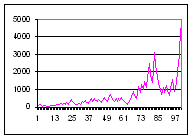
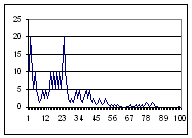
Scenario 2 (Data File)
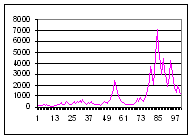
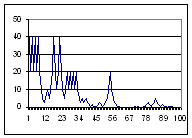
Scenario 3 (Data File)
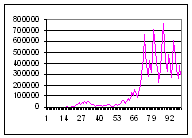
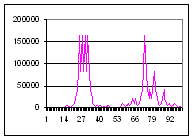
Scenario 4 (Data File)
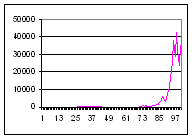
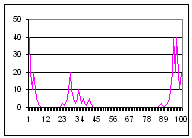
Scenario 5 (Data File)
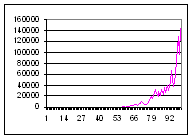
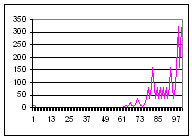
As you can see from every single graph above, no matter how low or high the asset price went, it still seemed to generate a handsome profit. Although I didn’t post any of the graphs where the asset loses all of its value, you can see from some of the examples that even when the asset price is almost completely wiped out the wealth graph is still much higher than the original $200 in wealth. It’s also much higher than if you had just stayed and rode the stock all along!
Of course please don’t think that I’m proposing that getting in and out of the assets is necessarily a good thing, because like I mentionned before, once you start to take into account the transaction costs and capital tax costs, not to mention the amount of time it takes for a normal asset to double and halve, it pretty much makes this model impossible. I still strongly believe in the buy and hold model and therefore this article is more to bring forth some new ideas and ways of thinking about assets and risk management.
Permalink to this article Discussions (3)
Can You Save Your Way to a $1,000,000 Dollars?
I recently had a discussion with a friend of mine on whether or not it’s possible to save your way to a million dollars or if it’s only possible to earn it. We talked about it from many angles, and yes it’s possible, but it’s very unlikely. You’ll have to live very cheaply for a long time, at least more much more cheaply than I care to.
So how did we come up with this finding? Like most of the other articles on this blog, I worked out the numbers. Today’s article is all about the numbers we worked out during that discussion. We’ll start from one angle and then work the what-if’s, how-to’s, and what-about’s after.
Ok, let’s start with a basic premise, let’s start with a salary. Where do we start here? To make things simple, let’s take the median Californian’s household salary of about $54k. Let’s assume a 25% tax rate straight off the top (which is probably lower than the actual rate, therefore working in our favor), leaving us with $40.5k in net income. Now, according to “The Wealthy Barber”, we should invest 10% of our income. Again to pad it in our favor, let’s make that 10% of gross (pre-tax income) rather than the net income. This means we will put away $5.400 a year into an investment instead of $4,050. As for the interest rate, let’s take an easy to measure interest rate, the current 30-year fixed US Treasuries rate of 5.375%/year. After 30 years, you would have $391,792.50 in your account. You’d be short about 61% of your goal of a million dollars!
Alright, now that we have a baseline, let’s start looking at these numbers in more detail, let’s change them, and let’s work with different assumptions. Ok, first, what if instead of 10% we saved 20%? What difference would that make? $783,585.05. Much closer but still over 21% short of our one million dollar goal. To make our goal of one million dollars we would need to put away $13,782.81 each year! Assuming a median income of $54k, that represents over 25% of gross income, or over 34% of net income! In other words, for ever dollar you take home after taxes, you need to put 34 cents into your investments, you need to live off of just under $27k a year. In California, assuming the rent is at least $1k a month (which is low), that means you need to live on $15k a year for everything (car, food, health, kids, entertainment, travel, etc.) for 30 years! That’s not very much, not much at all.
Ok, let’s look at it from another angle. What if we increased the interest rate to a more aggressive interest rate? Let’s take the average compound rate of return on stocks from 1802 through 1991, 7.7% per year. Assuming this rate of return with our original 10% of gross, would we make our one million dollars in 30 years? Unfortunately no, we would have made only $609,226.29, still shy over 39% of our targeted one million dollars. At that rate of return, we would need to invest $8,863.71/year, over 16% of our gross or almost 22% of our net. Although possible, I personally think that consistently investing 20% or more of the net income of the median family is probably asking for too much for the ordinary person. Investing 20% of 100k net in revenue is possible, but not for the median income family, it’s just too much.
Ok, so let’s look at it this way, assuming we want to save only 10% of our net income, the smaller of the two numbers, at the higher rate of 7.7%, then how much income would we need to produce? $88,637.11 in net income. Assuming a tax bracket of 25% again (it’s probably higher as taxes get progressively higher with additional income), then we would need to make $118,182.81 in gross yearly revenue!
The next question that comes to my mind is what interest rate would you need to earn on the median salary to have 1 million dollars after 30 years, assuming you’re putting away 10% of the net income of the median household income of $54k? You would need to earn consistently over 30 years 10.139% compounded interest a year. This is very doable, however it tells me that I most likely need to be a smart equity investor, a smart real estate investor, or start my own business. Chances are that I won’t attain my 1 million dollar mark (in today’s dollars) otherwise.
Now I can already see some of you saying that with inflation, one million dollars isn’t going to be anything in 30 years. Very true, but remember these calculations are in today’s dollars. That is, what you have in the bank (or in investments) then will buy the same amount of stuff then as it does today if you had a million dollars today. In actually, if you add inflation into the calculations, these numbers look even worse because you now have to reduce your real interest rate by 3.5% (today’s inflation rate). So if you make 7.7%, you’re actually only making 4.2%!
I can also suspect some of you will comment about increasing your income, and hence contributions, over time. Yes, that’s all true and all, and I completely agree. The thinking is that although you might not make over $100k today, you will tomorow so you should be able to play catch up by putting away bigger and bigger amounts. Yes, this is true, sort of except that there’s a catch! This is where the power of compound interest becomes very very interesting! Again, nothing speaks as well as working out the numbers, so let’s do just that.
Say I invest 10k in year 1 and do nothing for 10 years at 7.7%. I will end up with $100,003.52 after 30 years. Now, what if I invest $1k every year for 30 years (i.e. I invest for a total of $30k)? I will end up with only $112,819.69, a difference of about 10%! Wow! I invested 3 times as much money only to make 10% more! Catching up really didn’t help much.
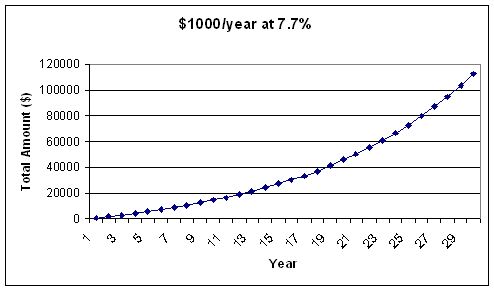
Of course, in the example above we spread it out over 30 years. What if we do the same numbers, but over 10 years now? Get ready for a shock! For the initial $10k investment in the first year and nothing after I end up with $21,544.60. If I do the second scenario, investing $1.5k a year for 10 years, I end up with $21,706.79. I actually have to invest 50% more money to get the same final balance.
Let’s look at the effects of compound with one last example. Let’s say I have no money initially, so I invest nothing for 10 years. Then for the next 10 years I invest $2k a year, then for next 10 years after that I invest $3k a year, what will I end up with? $105,768.77! Wow! I end up with almost the exact same as if I invested $10k the first year. I have to invest a total of $50k to catch up to my initial $10k investment. 5 times as much money to end up with about the same final amount! That’s the power of compound interest!
You can play with the numbers, but you’ll find that as interest rates climb, the differences become even more staggering. Basically the idea is that you should let time be your friend. The longer you can compound a number the higher the return. Remember, compound interest is an exponential formula, so use its power to your advantage. Put as much as you can early on, it’ll make a world of difference tomorrow because its very costly to catch up later. Therefore using the argument that you’ll be making more money later and hence bigger investments is probably not a good one.
All in all, it’s possible to save a million dollars but the odds need to be in your favor. The math above assumes historical averages with median salaries. The math here does not deal with factors such as unemployment losses (you’ll probably have some bad months in your life, etc. The numbers also doesn’t deal with inflation which could substantially affect the results. Also, since these calculations don’t consider inflation, they assume that you’re gaining the full stock return which is completely untrue! For example, if you’re stocks went up say 10% this year, then you only really made 6.5% after adjustments for inflation. That’s right, you need to remove 3.5% for inflation. So for example if you had $100 invested and you made $10 for a total of $110, then you’re $110 can only buy $107 of equivalent goods as compared to your $100. As a more concrete example, if you could buy gold at $1/lbs, then in year one you could buy 100 lbs of gold. In year two gold would have gone up to $1.035/lbs because of inflation (assuming a 3.5% inflation rate), allowing you to buy only 107 lbs and not 110 lbs. This means that in reality our calculations are better than reality because we didn’t take this inflation into consideration.
Also, these calculations assume you never pay taxes on your investments. If you do pay capital appreciation taxes then the numbers change drastically. Therefore, a quick tip for this type of investing, try to pick investment vehicles that you can stay with for a longer term to avoid taxes because they can have drastic differences in these calculations as seen in my previous article on the affect of taxes on the real estate investment returns.
Now that you know most of the math what do you think? I personally don’t think it’s feasible to assume most people will be able to save and invest $1,000,000 dollars in 30 years. Not that it’s impossible, people have done it, but I don’t know that I want to live that type of financially squeezed lifestyle. Rather I think you’ll have to look at other avenues to increase your revenues (or rate of return) rather than just try to save your way to $1,000,000. You should probably look into investing wisely in equities, real estate, or building your own business. Basically, you need to look at something other than just putting money away in your mattress, because the honest truth is that in 30 years you’ll likely not have the $1,000,000 you worked so hard to save for, you’ll only have a fraction of that. I’m not saying don’t invest, I would never say that, actually I’m a very strong proponent of investing. All I’m saying is that you probably need more than just plain saving in your financial plan to get your $1,000,000.
Permalink to this article Discussions (22)
| « PREVIOUS PAGE |



